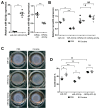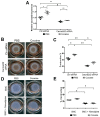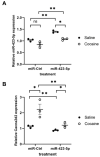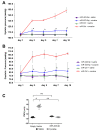MicroRNA-423-5p Mediates Cocaine-Induced Smooth Muscle Cell Contraction by Targeting Cacna2d2
- PMID: 37047559
- PMCID: PMC10094933
- DOI: 10.3390/ijms24076584
MicroRNA-423-5p Mediates Cocaine-Induced Smooth Muscle Cell Contraction by Targeting Cacna2d2
Abstract
Cocaine abuse increases the risk of atherosclerotic cardiovascular disease (CVD) and causes acute coronary syndromes (ACS) and hypertension (HTN). Significant research has explored the role of the sympathetic nervous system mediating the cocaine effects on the cardiovascular (CV) system. However, the response of the sympathetic nervous system alone is insufficient to completely account for the CV consequences seen in cocaine users. In this study, we examined the role of microRNAs (miRNAs) in mediating the effect of cocaine on the CV system. MiRNAs regulate many important biological processes and have been associated with both response to cocaine and CV disease development. Multiple miRNAs have altered expression in the CV system (CVS) upon cocaine exposure. To understand the molecular mechanisms underlying the cocaine response in the CV system, we studied the role of miRNA-423-5p and its target Cacna2d2 in the regulation of intracellular calcium concentration and SMC contractility, a critical factor in the modulation of blood pressure (BP). We used in vivo models to evaluate BP and aortic stiffness. In vitro, cocaine treatment decreased miR-423-5p expression and increased Cacna2d2 expression, which led to elevated intracellular calcium concentrations and increased SMC contractility. Overexpression of miR-423-5p, silencing of its target Cacna2d2, and treatment with a calcium channel blocker reversed the elevated SMC contractility caused by cocaine. In contrast, suppression of miR-423-5p increased the intracellular calcium concentration and SMC contractibility. In vivo, smooth muscle-specific overexpression of miR-423-5p ameliorated the increase in BP and aortic stiffness associated with cocaine use. Thus, miR-423-5p regulates SMC contraction by modulating Cacna2d2 expression increasing intracellular calcium concentrations. Modulation of the miR-423-5p-Cacna2d2-Calcium transport pathway may represent a novel therapeutic strategy to improve cocaine-induced HTN and aortic stiffness.
Keywords: blood pressure; cocaine; intracellular calcium; microRNA; smooth muscle cells.
Conflict of interest statement
The authors declare no conflict of interest.
Figures







Similar articles
-
Cocaine Exposure Increases Blood Pressure and Aortic Stiffness via the miR-30c-5p-Malic Enzyme 1-Reactive Oxygen Species Pathway.Hypertension. 2018 Apr;71(4):752-760. doi: 10.1161/HYPERTENSIONAHA.117.10213. Epub 2018 Feb 26. Hypertension. 2018. PMID: 29483230 Free PMC article.
-
MicroRNA MiR-199a-5p regulates smooth muscle cell proliferation and morphology by targeting WNT2 signaling pathway.J Biol Chem. 2015 Mar 13;290(11):7067-86. doi: 10.1074/jbc.M114.618694. Epub 2015 Jan 16. J Biol Chem. 2015. PMID: 25596533 Free PMC article.
-
Role of miR-185-5p as modulator of periostin synthesis and smooth muscle contraction in asthma.J Cell Physiol. 2022 Feb;237(2):1498-1508. doi: 10.1002/jcp.30620. Epub 2021 Oct 26. J Cell Physiol. 2022. PMID: 34698372 Free PMC article.
-
MicroRNA-499-5p promotes vascular smooth muscle cell proliferation and migration via inhibiting SOX6.Physiol Genomics. 2023 Feb 1;55(2):67-74. doi: 10.1152/physiolgenomics.00165.2021. Epub 2022 Oct 17. Physiol Genomics. 2023. PMID: 36250561
-
Intracellular and exosomal microRNAome profiling of human vascular smooth muscle cells during replicative senescence.Am J Physiol Heart Circ Physiol. 2021 Oct 1;321(4):H770-H783. doi: 10.1152/ajpheart.00058.2021. Epub 2021 Sep 10. Am J Physiol Heart Circ Physiol. 2021. PMID: 34506226
Cited by
-
Can O-GIcNAc Transferase (OGT) Complex Be Used as a Target for the Treatment of Hematological Malignancies?Pharmaceuticals (Basel). 2024 May 22;17(6):664. doi: 10.3390/ph17060664. Pharmaceuticals (Basel). 2024. PMID: 38931332 Free PMC article. Review.
-
miRNAs and Substances Abuse: Clinical and Forensic Pathological Implications: A Systematic Review.Int J Mol Sci. 2023 Dec 4;24(23):17122. doi: 10.3390/ijms242317122. Int J Mol Sci. 2023. PMID: 38069445 Free PMC article.
References
-
- Singh V., Rodriguez A.P., Thakkar B., Savani G.T., Patel N.J., Badheka A.O., Cohen M.G., Alfonso C.E., Mitrani R.D., Viles-Gonzalez J., et al. Hospital Admissions for Chest Pain Associated with Cocaine Use in the United States. Am. J. Med. 2017;130:688–698. doi: 10.1016/j.amjmed.2016.12.003. - DOI - PubMed
MeSH terms
Substances
Grants and funding
LinkOut - more resources
Full Text Sources
Medical

